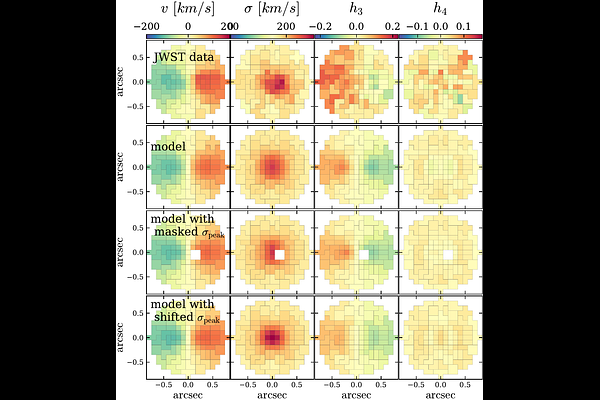A JWST View of the Overmassive Black Hole in NGC 4486B

A JWST View of the Overmassive Black Hole in NGC 4486B
Behzad Tahmasebzadeh, Matthew A. Taylor, Monica Valluri, Haruka Yoshino, Eugene Vasiliev, Michael J. Drinkwater, Solveig Thompson, Kristen Dage, Patrick Côté, Laura Ferrarese, Tatsuya Akiba, Vivienne Baldassare, Misty C. Bentz, John P. Blakeslee, Holger Baumgardt, Youkyung Ko, Chengze Liu, Ann-Marie Madigan, Eric W. Peng, Joel Roediger, Kaixiang Wang, Tyrone E. Woods
AbstractWe present a new stellar dynamical measurement of the supermassive black hole (SMBH) in the compact elliptical galaxy NGC 4486B, based on integral field spectroscopy with JWST/NIRSpec. The two-dimensional kinematic maps reveal a resolved double nucleus and a velocity dispersion peak offset from the photometric center. Utilizing two independent methods-Schwarzschild orbit-superposition and Jeans Anisotropic Modeling-we tightly constrain the black hole mass by fitting the full line-of-sight velocity distribution. Our axisymmetric Schwarzschild models yield a best-fit black hole mass of $M_{BH} = 3.6^{+0.6}_{-0.6} \times 10^8 \, M_{\odot}$, slightly lower but significantly more precise than previous estimates. However, since our models do not account for the non-equilibrium nature of the double nucleus, this value may represent a lower limit. The inferred black hole mass corresponds to approximately 4-13% of the total stellar mass, providing robust evidence for an overmassive SMBH in NGC 4486B. Combined with the galaxy's location deep within the Virgo Cluster, our results support the interpretation that NGC 4486B is the tidally stripped remnant core of a formerly massive galaxy. As the JWST/NIRSpec field of view is insufficient to constrain the dark matter halo, we incorporate archival ground-based long-slit kinematics extending to 5 arcsec. While this provides some leverage on the dark matter content, the constraints remain relatively weak. We place only an upper limit on the dark matter fraction, with $M_{DM}/M_{*} < 0.5$ within 1 kpc-well beyond the effective radius. The inferred black hole mass remains unchanged with or without a dark matter halo.